Photographs: Nirdesh K Singh Nirdesh K Singh
Here's the fascinating history of the Karnataka's contribution to Indian rock-cut architecture.
Pulakesi I knew that soon he will have to look for a more secure capital for his fledgling kingdom of the Early Chalukyas. The Pallavas who ruled Northern Tamil Nadu and Southern Andhra Pradesh from Kanchipuram were a constant threat. The Pallavas would later disrupt the Early Chalukyas dynasty for thirteen years. Threat would also come from Rashtrakutas who were feudatories of the Early Chalukyas and will ultimately overthrow the Early Chalukyas. Rashtrakutas established their capital in Malkhed about 300 kms North East to Badami in the district of Gulbarga. The Rashtrakutas later commissioned more temples in Aihole, Badami and Pattadakal and built the most magnificent temple of all, the Kailash Temple in Ellora.
Aihole lies on relatively rocky plain land. Only the Malaprabha river provided some defence in the West. Pulakesi I did not have to look far. Badami, then known as Vatapi was just 30 kms to the West. Badami by some quirk of nature had high rocky outcrops which could be easily defended. Pulakesi I shifted his capital to Badami in 540 AD and it remained the capital till 757 AD. So while Badami became the political capital, Aihole continued to serve as the commerce capital.
The Badami Temples are attributed to the sons of Pulakesi I -- Kirtivarman I (566-597 AD) and Mangalesa (597-610AD). Mangalesh commissioned the grandest Cave Three temple and is regarded as the Father of Chalukya Architecture. Pulakesi II, son of Kirtivarman I killed his ambitious Regent uncle Mangalesh and ascended the throne.
Apparently, this trait of killing family members was not unique to the Mughals and possibly extends to the entire ruling class. Pulakesi II was perhaps the best known Chalukyan King when the kingdom was at its peak and extended from Narmada to Cauveri. He led several victorious campaigns against the Pallavs in South and Harsh of Kannauj in the North. The Chinese traveller Hieun Tsang's memoirs records Pulakesi II victory over Harshvardhan on the banks of Narmada River. Hieun Tsang who visited Pulakesi II's court was impressed with the administration and the state of the people. Badami Chalukyas went into a brief decline upon the death of Pulakesi II in 642 AD when the Pallavs ruled for thirteen years.
Vatapi which was the original name of capital has mythological connection to Ramayana. While Chitradurga had the demon brother & sister Hidimba and Hidimbi snacking on people, Badami had its own demon siblings Vatapi and Ilvala who, surprise, also had affinity to human meat of mendicants. The elder Ilvala would turn Vatapi into a sheep and offer its meat to the passing poor person.
Once the person ate the meat, Ilvala who had the gift of calling a person even from netherland, would call Vatapi's name. Vatapi would emerge from the person's body, thus killing him. However, Sage Agastya had other ideas. He digested the meat of the sheep before Ilvala could call out Vatapi's name thus significantly increasing mendicants' life expectancies in the area. The two hills in Badami are believed to be the demon brothers. Later the place was named Badami probably because of the almond (Badam) coloured rocks in the area.
IN PICS: The amazing story of the Badami cave temples
Image: North Hill, Lake and Badami Town -- View from South HillPhotographs: Nirdesh K Singh
You have started from Bagalkot and your first stop is Badami. You have only one day to see the triple wonders of Badami, Pattadakal and Aihole.
It is hot and the area is drought affected. You drive into the dusty town and abruptly turn left into the parking lot. The parking lot seems to be at the foot of this ravine with sandstone hills rising on either side. On the right, the red rocky outcrop rises almost vertically housing the rock-cut temples.
On the top of this South Hill sits the Badami Fort. Few yards straight ahead to the parking lot is the lake called Agastya Teertha hemmed in between the two hills. On the left of the lake is the North Hill of Badami.
North Hill also has fort ramparts, few temples, guard posts and the ASI Museum. The forts were initially built by Chalukyas and Rashtrakutas and then Tipu Sultan installed cannons and his treasury to the original structures. On the west, the town is threatening to push into the lake with houses built on the edge of the lake.
Beware of a snarling dog that apparently dislikes city slickers and is ready to chew your neck. Into the east, you can see the Bhootnath Temple complex built on the edge of the lake with another hill rising behind it. Kids bathe in the cool lake water and women wash laundry spreading it on the steps.
While the hills provided the needed security, they also provided the fabulous looking red sandstone that was scooped out to build the magnificent rock- cut cave temples Badami is famous for.
Four such rock cut temples have been sculpted out of the South Hill. Each temple has the basic architecture: The mukha mandapa or verandah with stone pillars and corbels leading to the columned mandapa or the main hall. Deep inside is the square garbh graha or the sanctum sanctorum. The temples date from 6th to 8th century. The richly carved temples provide testimony to the developed skills of the Early Chalukyas' craftsmen. Here in Badami they exhibited their considerable skills acquired in the laboratory of Aihole.
IN PICS: The amazing story of the Badami cave temples
Image: Cave 1: Dancing Natraj with 18 ArmsPhotographs: Nirdesh K Singh
Cave 1 (543 AD) is a Shiva Temple and was the first to be excavated. The temple walls depict the family of Shiva including Durga-Mahishamardini, Kartikey and Ganesh.
The most celebrated sculpture is that of the 18 armed dancing Nataraj demonstrating eighty one mudras. Nataraj, Lord of Dance, is the cosmic dancer Shiva, performing divine dance to destroy the universe paving way for its creation.
The entire panel radiates vigorous energy and motion of the Shiva Tandav Nrutya with Ganesh and Nandi also joining in the dance. The musician is playing tripura vaadya.
IN PICS: The amazing story of the Badami cave temples
Image: Cave 1: ArdhanareeshwarPhotographs: Nirdesh K Singh
Another magnificent statue is that of Ardhanareeshwar -- composite form of Shiv and Parvati.
The statue is flanked by the three legged, tenacious and almost skeletal Sage Bhringi, a great devotee of Shiva; the bull Nandi who is Shiva's vehicle; and a friend of Parvati. Notice the mythical animals depicted on the corbels above. Another statue depicts Harihar or Shiv Narayan, the fusion form of Vishnu (Hari) and Shiv (Har).
Shiv's side has Parvati and Nandi, with snakes on arm and ardh chakra, while Vishnu's side has Lakshmi and Garud, jewelled crown on the head, arm holding the conch and adorned with jewels.
The frieze below contains several dwarfs or gan in various postures. Some celestial couples adorn the ceiling.
IN PICS: The amazing story of the Badami cave temples
Image: Cave 2: VarahPhotographs: Nirdesh K Singh
Cave 2 is dedicated to Lord Vishnu.
Vishnu's third avatar Varah -- the Wild Boar is depicted zoo-anthropomorphically with one hand rescuing the earth Bhudevi from the ocean and with one foot resting on the netherland or pataal.
This probably was the first time when a human neck was shown attaching the boar head with human body. The Nag King Vasuki worships the feet of Lord Vishnu. During the Samundra Manthan, Vasuki allowed himself to be used as the churning rope.
Varah was the royal emblem of the Chalukyas and was later adopted by Vijaynagar Empire. Another statue depicts Vaman -- Vishnu's fifth avatar.
The panel depicts Vaman in King Bali's court measuring earth with one foot and the other foot reaching the sky, Vaman the dwarf Brahmin, Bali -- the pious King of Demons, King Bali's guru Sukracharya and King Bali falling at Lord Vishnu's feet.
IN PICS: The amazing story of the Badami cave temples
Image: Cave 2: Swastik on the roofPhotographs: Nirdesh K Singh
On the ceiling is an incredible four branched Swastik.
IN PICS: The amazing story of the Badami cave temples
Image: Cave 3: Narsimha and VamanPhotographs: Nirdesh K Singh
Cave 3 (578 AD) is also dedicated to Lord Vishnu and is the most eye popping. Mangalesh built this temple in memory of his brother Kirtivarma's rule. The cave looks splendid with mix of painting and sculptures on every available inch of stone; something similar to First Cave in Ajanta but on a smaller scale. The statues and sculptures are more elaborate as if the second cave just whetted their appetite and the master craftsmen now wanted to create more masterpieces.
The cave has statue of Narasimha, the lion-man incarnation of Lord Vishnu. Narasimha has head of lion, body of human and claws. Prahlad's devotion to Vishnu brought his demon father Hiranyakashyap's end at the hands, er, claws of Narasimh. Narasimha is usually shown sitting and angry but here the statue is standing and probably even smiling. The corbels surrounding Narasimh are exquisite.
IN PICS: The amazing story of the Badami cave temples
Image: Cave 3: Lord Maha VishnuPhotographs: Nirdesh K Singh
On one side of the mukha mandapa, Lord Maha Vishnu is depicted sitting – instead of the usual reclining position - on the coiled five headed Anant Shesh. The carving includes diamond crown, ornamented arms, karna kundal around the waist.
IN PICS: The amazing story of the Badami cave temples
Image: Cave 3: Paintings on the CeilingPhotographs: Nirdesh K Singh
The ceiling has several painted panels probably restored. True to tradition, Asht Dikpalaks or Guardians of Directions are represented on the ceiling. In the centre is Lord Indra, the King of Gods, Lord of Heaven and God of rain and thunderstorm. Also seen is Indra's vehicle Airavata.
IN PICS: The amazing story of the Badami cave temples
Image: Cave 3: Sculpted pillars and corbelsPhotographs: Nirdesh K Singh
The corbels have divine couples or yakshs in various postures.
IN PICS: The amazing story of the Badami cave temples
Image: Cave 4: BahubaliPhotographs: Nirdesh K Singh
Cave 4 is dedicated to the Jain religion. Bahubali or Gomateshwar was the second son among the hundred sons of first Tirthankar Rishabh. The carving shows Bahubali meditating while vines climb the legs and serpants come out of the anthills hissing. Also, seen are Bahubali's sisters Brahmi and Sundari.
IN PICS: The amazing story of the Badami cave temples
Image: Cave 4: ParshvanathPhotographs: Nirdesh K Singh
Parshvanath was the 23rd Tirthankar and the most popular among Jains. Adishesh hoods the head.
The voluptuous Padmavati Yakshini holds an umbrella while her husband Dharanendra sits. The statues do not have clothes following the customs of Digambar Jains which means renunciation of all worldly possessions.
You have learnt more of Religion and Mythology from a single visit to Badami than your entire life.
It is not even twelve in the afternoon and the heat is searing. When you reach a place you first hit the fort and then if time permits you go see other attractions. But the height is too intimidating in this heat. You need to conserve energy for Pattadakal and Aihole.
The steps leading up to the South Hill fort are supposed to be narrow and steep and are closed for visitors after a fatal mishap. The closed gate is near the second cave. Fort hunters hire local guides and climb the hill from the back to reach the fort. North hill fort is open to visitors.
IN PICS: The amazing story of the Badami cave temples
Image: Monkey Family Enjoying Afternoon SiestaPhotographs: Nirdesh K Singh
You don't ever remember reading an ASI sign warning you of monkeys in the precincts of a monument. But here in Badami right at the entrance there is a warning that you are a fair game to a big community of monkeys. And it is so true. They are everywhere and every few minutes there is a scream, some clamour and you see a monkey gleefully flaunting a bottle or footwear or potato chip packets. But the May heat has wilted the monkeys and they decide to take a power nap before menacing the next visitor.
IN PICS: The amazing story of the Badami cave temples
Image: These cliffs will turn magical in the monsoonsPhotographs: Nirdesh K Singh
The best time of course to visit Badami or any place in India as you have found out are the rains. The hills would become lush; water streams forming the Akka-Tangi Water Fall cascades down the cliffs flowing into the Agastya Lake. The site would turn magical. Also then you can climb the hills, visit temples on North Hill along with the museum.
IN PICS: The amazing story of the Badami cave temples
Image: When in Badami, wear flowersPhotographs: Nirdesh K Singh
When in Badami Wear Flowers in your Hair
Though it is does not say on any sign but it is recommended that if you are going to Badami; be sure to wear some flowers in your hair!
Getting There: Badami is 40 kms district centre of Bagalkot, 22 kms from Pattadakal, 36 kms from Aihole and 500 kms north of Bangalore. Badami, Pattadakal and Aihole can all be visited in one day. But if you have time and it is the rainy season, Badami has enough to keep you there for two days. Trek up the hills to the forts, enjoy the rock formations, visit Sidlaphadi -- probable home to prehistoric humans and admire Banashankari and Mahakoota temples.
Since the writer is not an expert on mythology or religion, any misinterpretation or error is purely unintentional.

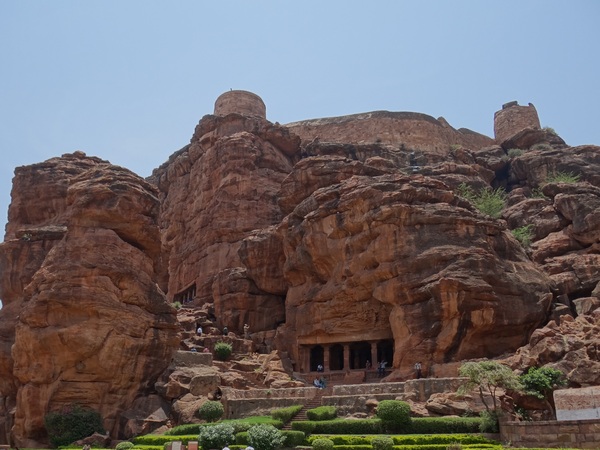

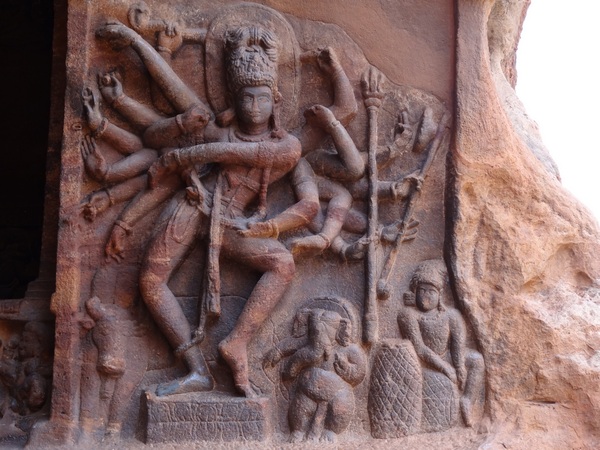


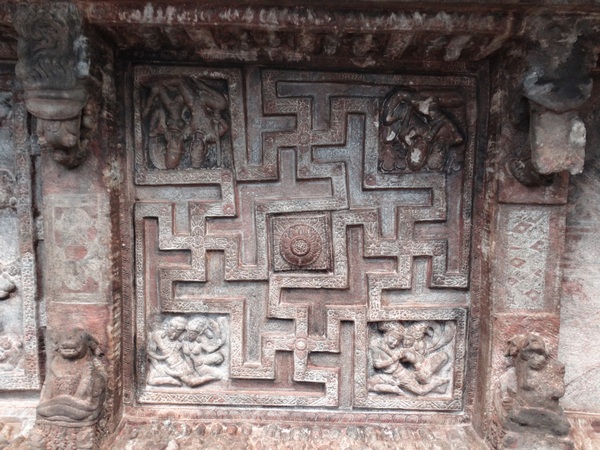
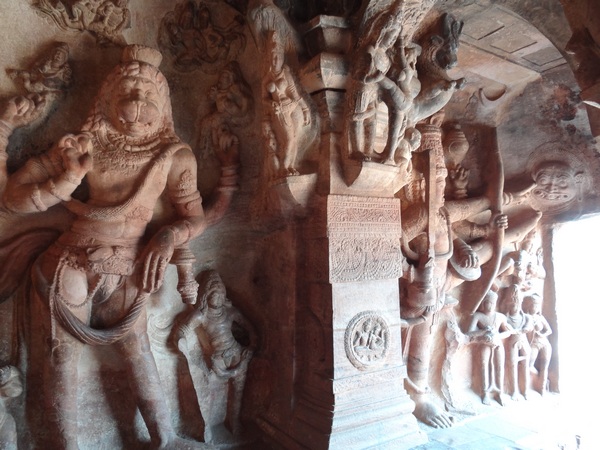
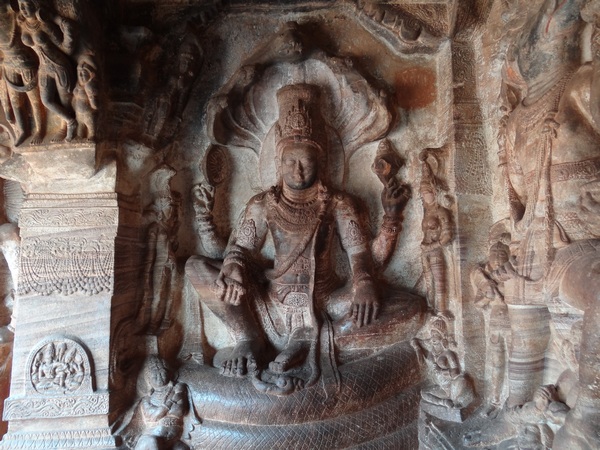
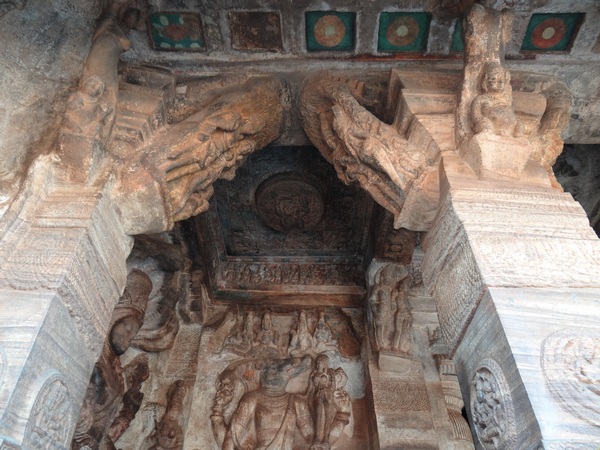
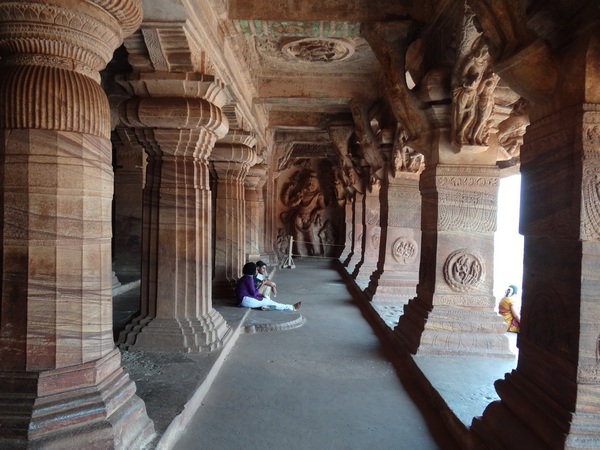


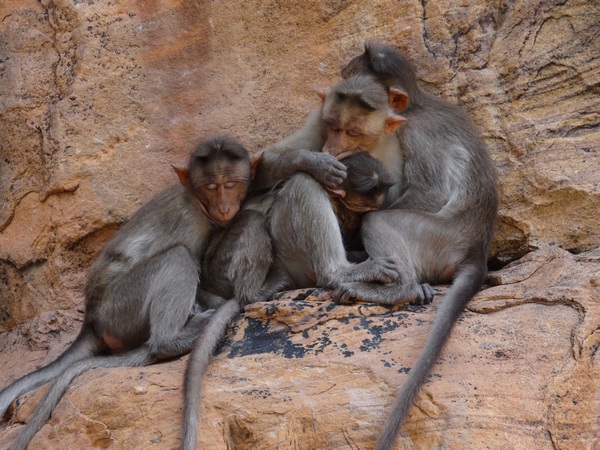
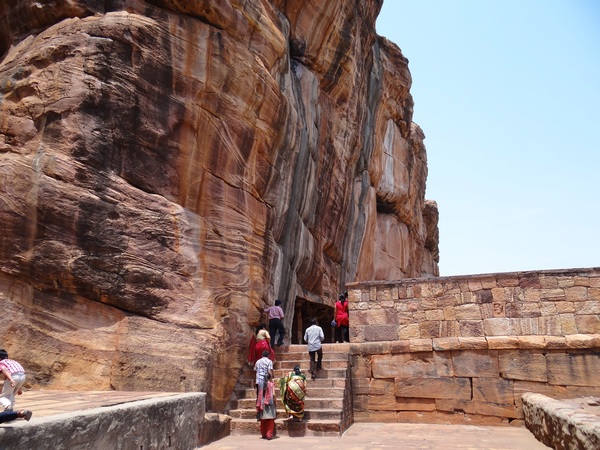

Comment
article